- Home
- About Us
- Join/Renew
- Member Benefits
- Member Pages
- Log In
- Help
- Museum Store
Home Page › Forums › General › What would the never produced 1934 Studebaker-based P-A’s have looked like?
There is something very Pierce-Arrow about the shape of the ’36 Studebaker 2/4 coupe’s rear glass. I put the headlamps on the fenders for a quick look/see.
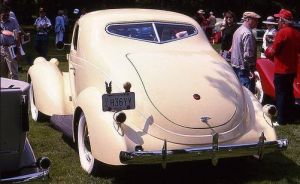
Welding the rear of the coupe’s roof, inclusive of backlight, to the sedan’s roof would have been unlikely given surfacing misalignment, but some time ago I worked out a scenario anyway, on 140 wb.
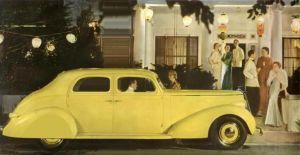
Back to main task at hand.
These final images are, in addition to 125 wb sedan and above 125 coupe, body styles that I think Pierce could have pursued and found good success with, based on the knowledge (stretched at times) and resources it would have had at the time.
First is 8 passenger sedan. Uses coupe’s front door. The only changes Pierce would have needed to make to its 125 sedan would have been a new tooled rear door set that was 5 inch longer than standard, 5 inch longer quarter side windows and a 15 inch wide roof insert welded in just aft of B-pillar. An appropriate amount of rework to create this needed car.
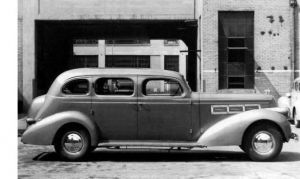
Now for the big investment in the shape soon to be adopted by the entire industry and led by GM. Really just an extension of 836A thinking but intended as flagship, not entry, and thus embellished in proportion on 8 pass sedan’s 140 inch wheelbase. New tooled rear quarter panels and decklid would have mated to 825’s roof and 840 8-pass doors.
Pierce might have even offered the body style with V12 exclusively, leveraging and enhancing that engine’s special marketing aura.
Shown in full streamlining mode with fender skirts added, running boards deleted.
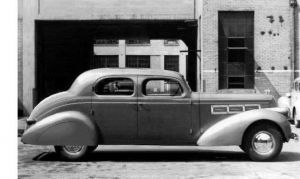
Agree with earlier comment that the 1934-5 1255 would have been a beast, and am not a fan of this car but if the 1255 had done well, could have continued on, further enhancing the Twelve series. This work-up uses the new sedan’s rear quarters and decklid, and doors and roof from 840 8-pass. Not much investment to bring to market, only question is whether there would have been a market.
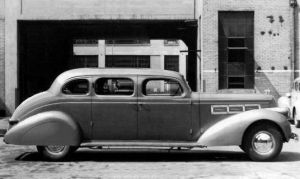
And finally, the new rear quarters and decklid mated to 125 wb platform and 2-door sedan’s longest front doors, which were several inches longer than even the 2 door rumble seat coupe’s. Tooling a new roof would not have been investment efficient given the limited market for big coupes so would have only been offered as a Victoria. Door sills shaved down an inch per typical Pierce-Arrow convertible/phaeton practice. Could have used production A-pillar but better still would have been a cast, chromed V-windscreen frame per the 1938 Studebaker convertible sedan and all the great classics.
Would-be showroom (excluding low volume 4-door convertible sedans/phaetons based on existing bodies):
825 6-pass 6-window Sedan
825 2/4 pass Coupe
840 8-pass 6-window Sedan (opt. division window)
1225 4-pass Victoria (w/fold-down opera seats)
1240 6-pass 4-Window Sport Sedan (opt. division window)
1255 8-pass 6-Window Sport Sedan (opt. division window)
Merry Christmas!!!
Paul
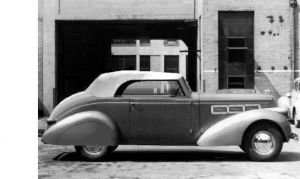
One more image just worked up by Santa’s elves this morning. My 1240 dream car. Would be happy if it had Eight too!
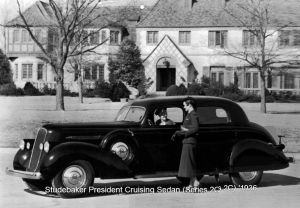
Hi Guys,
Have reworked few more period 1934 Studebaker images to depict Pierce, am amazed at what was possible. Found myself asking why those Buffalo businessmen accepted a go-it-alone deal instead of insisting on continued access to Studebaker’s body stampings, future technology such as independent front suspension, and shared sales channels. Did they think Studebaker would go under? One look at the planned new models should have allayed any fears.
From a historical perspective, Studebaker and Pierce-Arrow were early leaders of body sharing between mass and luxury marques, a strategy that proved indispensable for luxury car success from the mid-1930s well into the 1970s. Cadillac worked it better than anyone else.
Had those businessmen pursued even a scaled back version of the original 1934 plan, opting not to tool the faster rear roof and deck and instead simply extending the hood the intended 10 inches, using Studebaker bodies in whole or in case of 7 pass car, large part, sales would likely have increased over 1933 and Pierce could have quickly turned its affairs around just as Studebaker was able to do by 1935 when it came out of bankruptcy. That the company turned a small profit in second quarter 1933 was an indication of how close they were to the tipping point between success and failure.
I have pulled together pricing and sales data to project where Pierce might have gone beginning in 1934. First some eye candy.
High volume 133 wb sedan using 123 wb President body and Pierce’s 10 inch longer hood. Convertible sedan could have been offered too. Studebaker body stampings would have been shipped directly from stamping plant, pricing set at Studebaker cost or perhaps slightly higher, say 5%. Front fenders from 1933 836 with front fascia modified to look like either ’34 Studebaker or ’33 Silver Arrow show car. Grill could have been either a chromed version of Studebaker’s fixed design or identical to Silver Arrow show car including its thermostatically controlled louvers.
The businessmen would have needed to increase plant efficiency if they wanted to turn a profit. Job 1 would have been elimination of wood composite construction. Studebaker had already poured millions into the plant to enable all-steel body construction amongst other things, so the heavy lifting had already been done. Yes, some customers complained about the ’33 all-steel cars. But steel was the future and there was much more to like than dislike.
The line-up could have launched in November, 1933 since very little was needed by way of design and tooling, the new models hitting the market at the right time while allowing the businessmen to conserve cash. Pricing would have been very competitive and unlike 836A, would have delivered healthy margins.
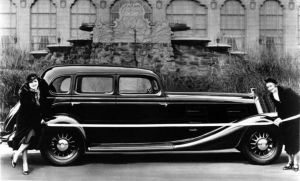
Is there a trick to getting the “Click picture for larger view”” to work?”
Not sure what the problem is but have concluded that best way to fix is to start a new thread.
